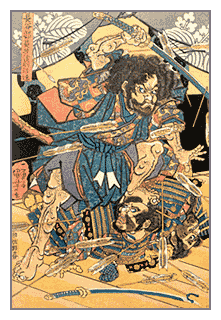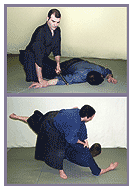 Warfare and the profession of arms have been a tradition in Japan long before the dawn of recorded history. Generally, the development of systemized martial traditions (bugei) did not arise until after the end of the Heian period of Japan's history (794-1185). The main purpose of the bugei was to train and prepare the samurai for battlefield combat. This training centered on the study of the bow (yumi), sword (tachi), and spear (yari), epitomized in the expression "Kyûba no michi," or "The Way of the bow and horse."
Warfare and the profession of arms have been a tradition in Japan long before the dawn of recorded history. Generally, the development of systemized martial traditions (bugei) did not arise until after the end of the Heian period of Japan's history (794-1185). The main purpose of the bugei was to train and prepare the samurai for battlefield combat. This training centered on the study of the bow (yumi), sword (tachi), and spear (yari), epitomized in the expression "Kyûba no michi," or "The Way of the bow and horse."
The Tokugawa Era (1603-1867) and the 250-year reign that brought peace to Japan ushered in fundamental changes to the teachings and practice of the bugei. The samurai found himself more in the role of a civil administrator than that of a battlefield warrior. Under Tokugawa, the ideal samurai was a man that strove for balance between bu (martial learning) and bun (civil learning). The concept is often expressed as: "A cart with two wheels is the two-fold path of bun and bu (pen and sword)." The ideal man (shi) was a warrior, a gentleman, and a scholar.
Many of the modern forms of budô (judô, kendô, iaidô, naginata-dô) were derived from the older systems of bugei. These more modern systems have modified training their methods, many delving into competitive sporting aspects and/or specializing on one specific area of study. The bugei however, are wide in scope and depth. They are intent upon maintaining the authenticity and practicality of their training and fighting methods. These components are essential to the learning process and development thereby, producing a specific mindset on which these systems were founded.



 Warfare and the profession of arms have been a tradition in Japan long before the dawn of recorded history. Generally, the development of systemized martial traditions (bugei) did not arise until after the end of the Heian period of Japan's history (794-1185). The main purpose of the bugei was to train and prepare the samurai for battlefield combat. This training centered on the study of the bow (yumi), sword (tachi), and spear (yari), epitomized in the expression "Kyûba no michi," or "The Way of the bow and horse."
Warfare and the profession of arms have been a tradition in Japan long before the dawn of recorded history. Generally, the development of systemized martial traditions (bugei) did not arise until after the end of the Heian period of Japan's history (794-1185). The main purpose of the bugei was to train and prepare the samurai for battlefield combat. This training centered on the study of the bow (yumi), sword (tachi), and spear (yari), epitomized in the expression "Kyûba no michi," or "The Way of the bow and horse." The Goho (hard) and Juho (soft) movements study defensive and offensive situations against armed or unarmed opponents. The Kobuho (weaponry) comprises different large and small weapons in varying situations. Finally, the Hassei-ho (medicine) tradition includes herbology, anatomy, medicinal theory, pressure-point manipulation and the underlying theories/strategies that makes these four areas a cohesive whole.
The Goho (hard) and Juho (soft) movements study defensive and offensive situations against armed or unarmed opponents. The Kobuho (weaponry) comprises different large and small weapons in varying situations. Finally, the Hassei-ho (medicine) tradition includes herbology, anatomy, medicinal theory, pressure-point manipulation and the underlying theories/strategies that makes these four areas a cohesive whole.